The General Dynamics F-16 Fighting Falcon is an American single-engine supersonic multirole fighter aircraft originally developed by General Dynamics for the United States Air Force (USAF). Designed as an air superiority day fighter, it evolved into a successful all-weather multirole aircraft with over 4,600 built since 1976.[4] Although no longer purchased by the U.S. Air Force, improved versions are being built for export. In 1993, General Dynamics sold its aircraft manufacturing business to the Lockheed Corporation,[5] which became part of Lockheed Martin after a 1995 merger with Martin Marietta.[6]The F-16's key features include a frameless bubble canopy for enhanced cockpit visibility, a side-mounted control stick to ease control while maneuvering, an ejection seat reclined 30 degrees from vertical to reduce the effect of g-forces on the pilot, and the first use of a relaxed static stability/fly-by-wire flight control system that helps to make it an agile aircraft. The fighter has a single turbofan engine, an internal M61 Vulcan cannon and 11 hardpoints. Although officially named "Fighting Falcon", the aircraft is commonly known by the nickname "Viper" among its crews and pilots.[7]In addition to active duty in the U.S. Air Force, Air Force Reserve Command, and Air National Guard units, the aircraft is also used by the U.S. Air Force Thunderbirds aerial demonstration team, the US Air Combat Command F-16 Viper Demonstration Team,[8] and as an adversary/aggressor aircraft by the United States Navy. The F-16 has also been procured by the air forces of 25 other nations.[9] As of 2025, it is the world's most common fixed-wing aircraft in military service, with 2,084 F-16s operational.[10]Development
Lightweight Fighter programUS Vietnam War experience showed the need for air superiority fighters and better air-to-air training for fighter pilots.[11] Based on his experience in the Korean War and as a fighter tactics instructor in the early 1960s, Colonel John Boyd with mathematician Thomas Christie developed the energy–maneuverability theory to model a fighter aircraft's performance in combat. Boyd's work called for a small, lightweight aircraft that could maneuver with the minimum possible energy loss and which also incorporated an increased thrust-to-weight ratio.[12][13] In the late 1960s, Boyd gathered a group of like-minded innovators who became known as the Fighter Mafia, and in 1969, they secured Department of Defense funding for General Dynamics and Northrop to study design concepts based on the theory.[14][15]
Air Force F-X proponents were opposed to the concept because they perceived it as a threat to the F-15 program, but the USAF's leadership understood that its budget would not allow it to purchase enough F-15 aircraft to satisfy all of its missions.[16] The Advanced Day Fighter concept, renamed F-XX, gained civilian political support under the reform-minded Deputy Secretary of Defense David Packard, who favored the idea of competitive prototyping. As a result, in May 1971, the Air Force Prototype Study Group was established, with Boyd a key member, and two of its six proposals would be funded, one being the Lightweight Fighter (LWF). The request for proposals issued on 6 January 1972 called for a 20,000-pound (9,100 kg) class air-to-air day fighter with a good turn rate, acceleration, and range, and optimized for combat at speeds of Mach 0.6–1.6 and altitudes of 30,000–40,000 feet (9,100–12,000 m). This was the region where USAF studies predicted most future air combat would occur. The anticipated average flyaway cost of a production version was $3 million. This production plan was hypothetical as the USAF had no firm plans to procure the winner.[17][18]Five companies responded, and in 1972, the Air Staff selected General Dynamics' Model 401 and Northrop's P-600 for the follow-on prototype development and testing phase. GD and Northrop were awarded contracts worth $37.9 million and $39.8 million to produce the YF-16 and YF-17, respectively, with the first flights of both prototypes planned for early 1974. To overcome resistance in the Air Force hierarchy, the Fighter Mafia and other LWF proponents[which?] successfully advocated the idea of complementary fighters in a high-cost/low-cost force mix.[19] The "high/low mix" would allow the USAF to be able to afford sufficient fighters for its overall fighter force structure requirements. The mix gained broad acceptance by the time of the prototypes' flyoff, defining the relationship between the LWF and the F-15.[20][21]
The YF-16 was developed by a team of General Dynamics engineers led by Robert H. Widmer.[22] The first YF-16 was rolled out on 13 December 1973. Its 90-minute maiden flight was made at the Air Force Flight Test Center at Edwards AFB, California, on 2 February 1974. Its actual first flight occurred accidentally during a high-speed taxi test on 20 January 1974. While gathering speed, a roll-control oscillation caused a fin of the port-side wingtip-mounted missile and then the starboard stabilator to scrape the ground, and the aircraft then began to veer off the runway. The test pilot, Phil Oestricher, decided to lift off to avoid a potential crash, safely landing six minutes later. The slight damage was quickly repaired and the official first flight occurred on time.[23] The YF-16's first supersonic flight was accomplished on 5 February 1974, and the second YF-16 prototype first flew on 9 May 1974. This was followed by the first flights of Northrop's YF-17 prototypes on 9 June and 21 August 1974, respectively. During the flyoff, the YF-16s completed 330 sorties for a total of 417 flight hours;[24] the YF-17s flew 288 sorties, covering 345 hours.[25]Air Combat Fighter competition
Increased interest turned the LWF into a serious acquisition program. NATO allies Belgium, Denmark, the Netherlands, and Norway were seeking to replace their F-104G Starfighter fighter-bombers.[26] In early 1974, they reached an agreement with the U.S. that if the USAF ordered the LWF winner, they would consider ordering it as well. The USAF also needed to replace its F-105 Thunderchief and F-4 Phantom II fighter-bombers. The U.S. Congress sought greater commonality in fighter procurements by the Air Force and Navy, and in August 1974 redirected Navy funds to a new Navy Air Combat Fighter program that would be a naval fighter-bomber variant of the LWF. The four NATO allies had formed the Multinational Fighter Program Group (MFPG) and pressed for a U.S. decision by December 1974; thus, the USAF accelerated testing.[27][28][29]To reflect this serious intent to procure a new fighter-bomber, the LWF program was rolled into a new Air Combat Fighter (ACF) competition in an announcement by U.S. Secretary of Defense James R. Schlesinger in April 1974. The ACF would not be a pure fighter, but multirole, and Schlesinger made it clear that any ACF order would be in addition to the F-15, which extinguished opposition to the LWF.[28][29][30] ACF also raised the stakes for GD and Northrop because it brought in competitors intent on securing what was touted at the time as "the arms deal of the century".[31] These were Dassault-Breguet's proposed Mirage F1M-53, the Anglo-French SEPECAT Jaguar, and the proposed Saab 37E "Eurofighter". Northrop offered the P-530 Cobra, which was similar to the YF-17. The Jaguar and Cobra were dropped by the MFPG early on, leaving two European and two U.S. candidates. On 11 September 1974, the U.S. Air Force confirmed plans to order the winning ACF design to equip five tactical fighter wings. Though computer modeling predicted a close contest, the YF-16 proved significantly quicker going from one maneuver to the next and was the unanimous choice of those pilots that flew both aircraft.[32]
On 13 January 1975, Secretary of the Air Force John L. McLucas announced the YF-16 as the winner of the ACF competition.[33] The chief reasons given by the secretary were the YF-16's lower operating costs, greater range, and maneuver performance that was "significantly better" than that of the YF-17, especially at supersonic speeds. Another advantage of the YF-16 – unlike the YF-17 – was its use of the Pratt & Whitney F100 turbofan engine, the same powerplant used by the F-15; such commonality would lower the cost of engines for both programs.[34] Secretary McLucas announced that the USAF planned to order at least 650, possibly up to 1,400 production F-16s. In the Navy Air Combat Fighter competition, on 2 May 1975, the Navy selected the YF-17 as the basis for what would become the McDonnell Douglas F/A-18 Hornet.[35][36]retrofitted to earlier aircraft. In addition, a manual override switch to disable the horizontal stabilizer flight limiter was prominently placed on the control console, allowing the pilot to regain control of the horizontal stabilizers (which the flight limiters otherwise lock in place) and recover. Besides reducing the risk of deep stalls, the larger horizontal tail also improved stability and permitted faster takeoff rotation.[46][47]
In the 1980s, the Multinational Staged Improvement Program (MSIP) was conducted to evolve the F-16's capabilities, mitigate risks during technology development, and ensure the aircraft's worth. The program upgraded the F-16 in three stages. The MSIP process permitted the quick introduction of new capabilities, at lower costs and with reduced risks compared to traditional independent upgrade programs.[48] In 2012, the USAF had allocated $2.8 billion (~$3.67 billion in 2023) to upgrade 350 F-16s while waiting for the F-35 to enter service.[49] One key upgrade has been an auto-GCAS (Ground collision avoidance system) to reduce instances of controlled flight into terrain.[50] Onboard power and cooling capacities limit the scope of upgrades, which often involve the addition of more power-hungry avionics.[51]
Lockheed won many contracts to upgrade foreign operators' F-16s. BAE Systems also offers various F-16 upgrades, receiving orders from South Korea, Oman, Turkey, and the US Air National Guard;[52][53][54] BAE lost the South Korean contract because of a price breach in November 2014.[55] In 2012, the USAF assigned the total upgrade contract to Lockheed Martin.[56] Upgrades include Raytheon's Center Display Unit, which replaces several analog flight instruments with a single digital display.[57]
In 2013, sequestration budget cuts cast doubt on the USAF's ability to complete the Combat Avionics Programmed Extension Suite (CAPES), a part of secondary programs such as Taiwan's F-16 upgrade.[58] Air Combat Command's General Mike Hostage stated that if he only had money for a service life extension program (SLEP) or CAPES, he would fund SLEP to keep the aircraft flying.[59] Lockheed Martin responded to talk of CAPES cancellation with a fixed-price upgrade package for foreign users.[60] CAPES was not included in the Pentagon's 2015 budget request.[61] The USAF said that the upgrade package will still be offered to Taiwan's Republic of China Air Force, and Lockheed said that some common elements with the F-35 will keep the radar's unit costs down.[62] In 2014, the USAF issued a RFI to SLEP 300 F-16 C/Ds.[63]
Activation Group
AG-1> Open Canopy
AG-2> Engine & Afterburner
AG-3> Formation Lights
AG-4> Activate Turnable Wheels
AG-5> Wing Lights
AG-6> Deploy Parachute
Specifications
Spotlights
- This craft is curated
- Mitterbin 5 months ago
General Characteristics
- Created On Android
- Wingspan 32.8ft (10.0m)
- Length 49.2ft (15.0m)
- Height 17.2ft (5.2m)
- Empty Weight 17,452lbs (7,916kg)
- Loaded Weight 22,285lbs (10,108kg)
Performance
- Power/Weight Ratio 3.63
- Wing Loading 67.1lbs/ft2 (327.4kg/m2)
- Wing Area 332.3ft2 (30.9m2)
- Drag Points 5016
Parts
- Number of Parts 190
- Control Surfaces 5
- Performance Cost 1,043

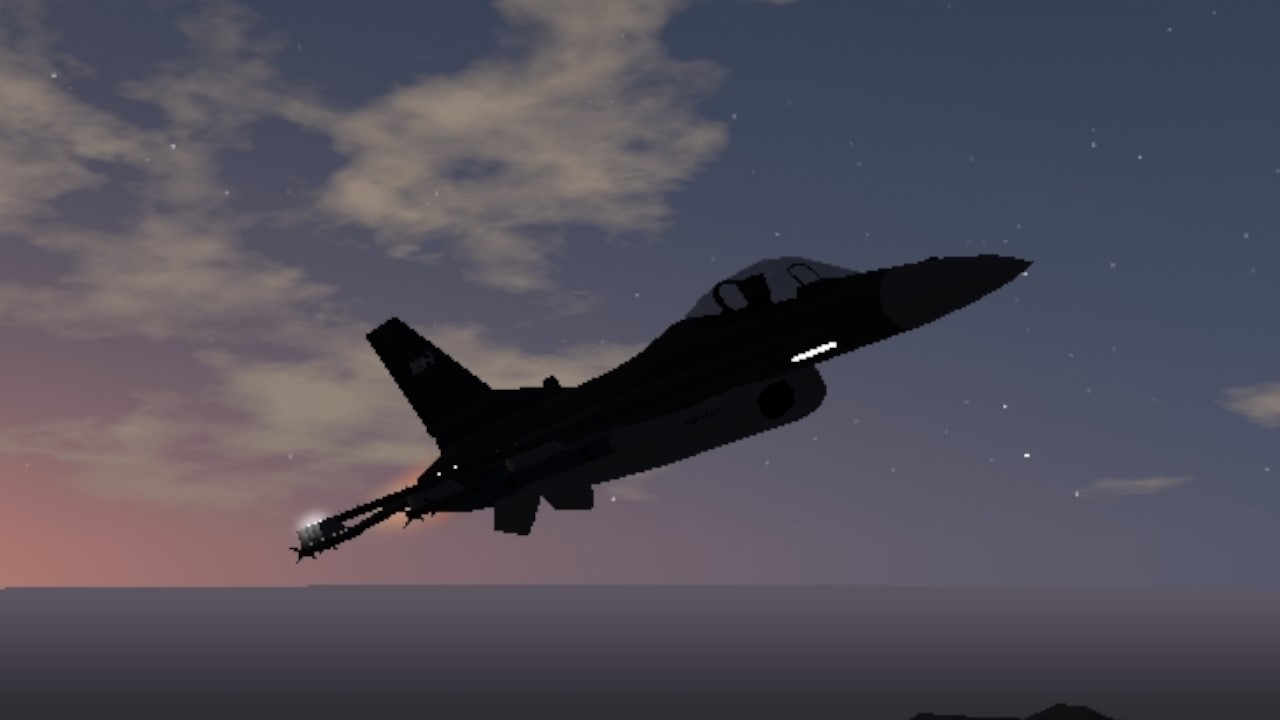
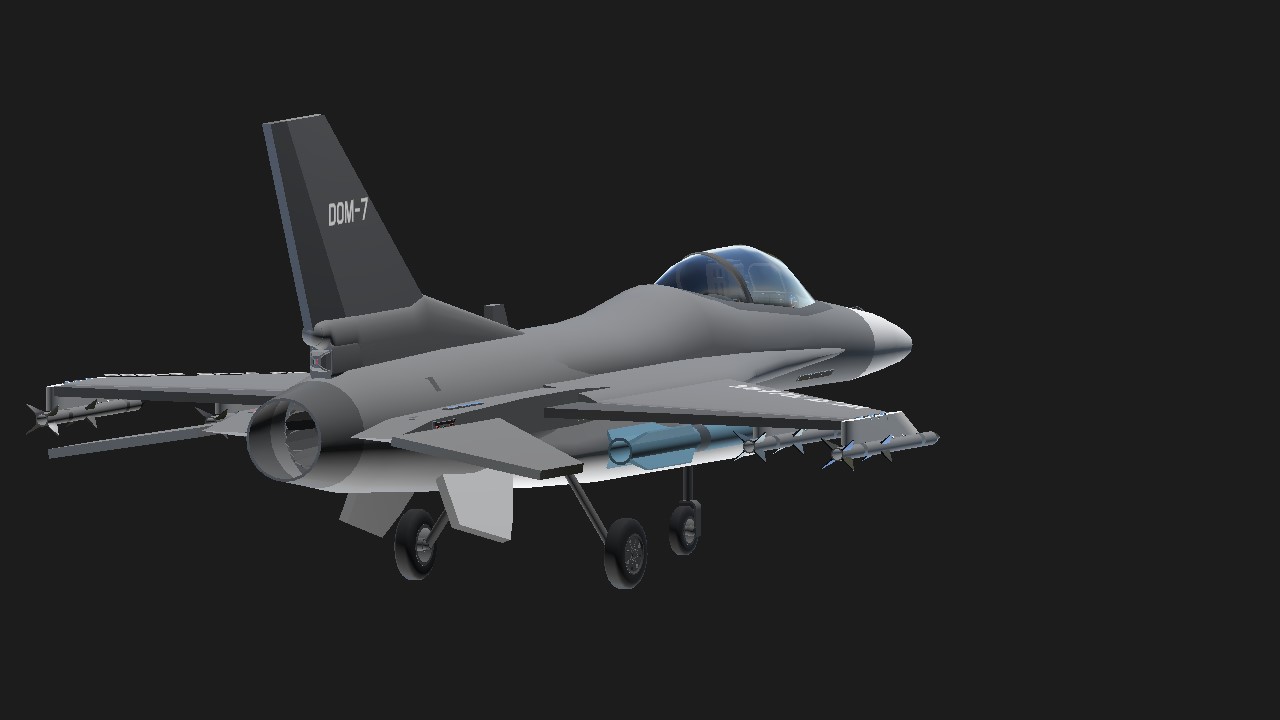
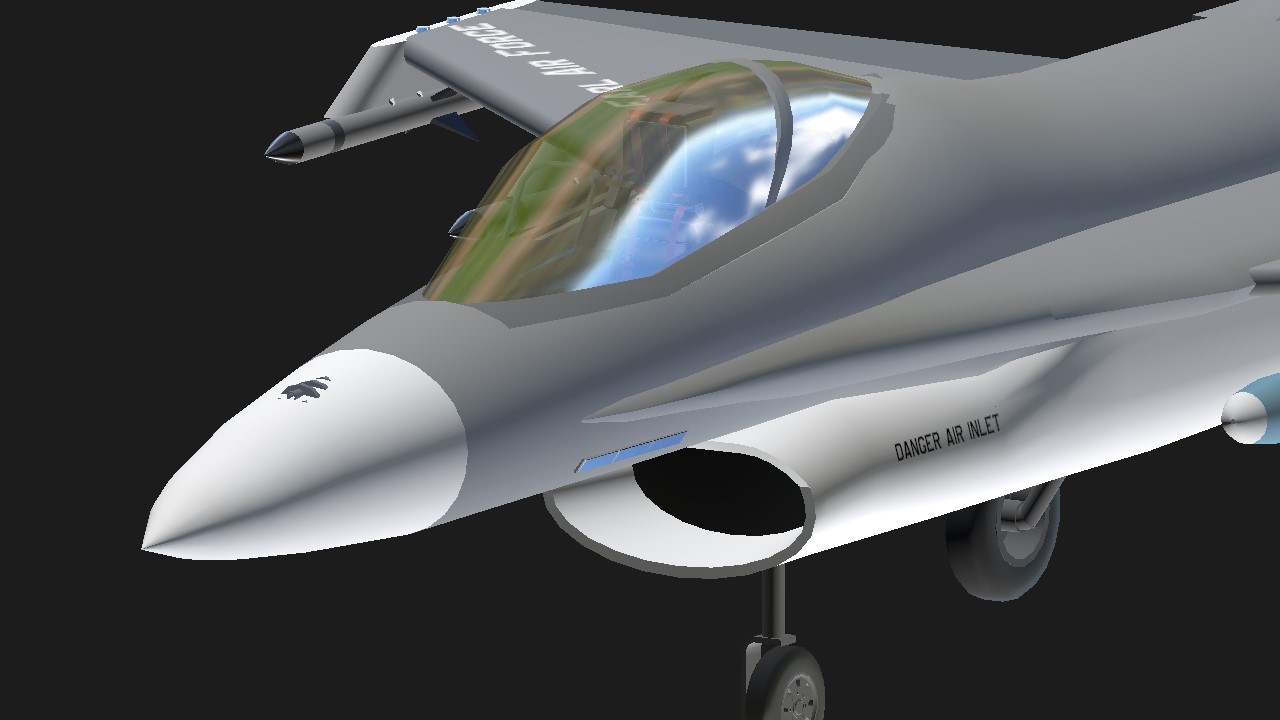
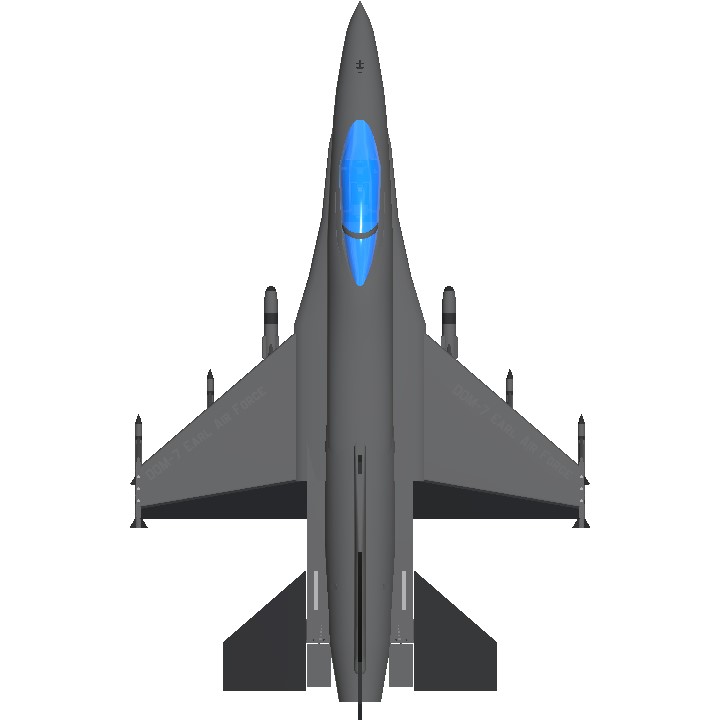
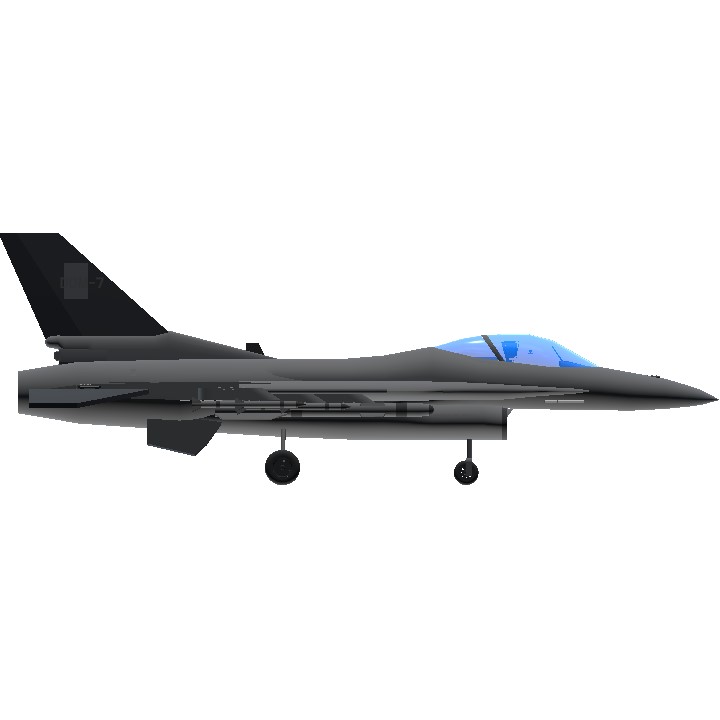
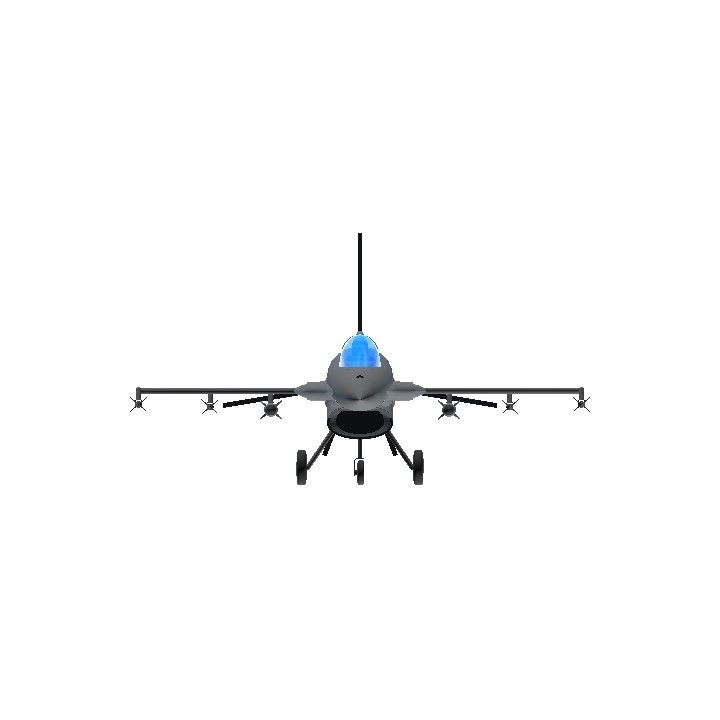
cool viper
@Mitterbin thanks!